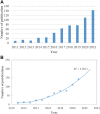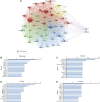Global trends in research on miRNA-microbiome interaction from 2011 to 2021: A bibliometric analysis
- PMID: 36110534
- PMCID: PMC9468484
- DOI: 10.3389/fphar.2022.974741
Global trends in research on miRNA-microbiome interaction from 2011 to 2021: A bibliometric analysis
Abstract
An increasing number of research suggests that the microRNA (miRNA)-microbiome interaction plays an essential role in host health and diseases. This bibliometric analysis aimed to identify the status of global scientific output, research hotspots, and frontiers regarding the study of miRNA-microbiome interaction over the past decade. We retrieved miRNA-microbiome-related studies published from 2011 to 2021 from the Web of Science Core Collection database; the R package bibliometrix was used to analyze bibliometric indicators, and VOSviewer was used to visualize the field status, hotspots, and research trends of miRNA-microbiome interplay. In total, 590 articles and reviews were collected. A visual analysis of the results showed that significant increase in the number of publications over time. China produced the most papers, and the United States contributed the highest number of citations. Shanghai Jiaotong University and the University of California Davis were the most active institutions in the field. Most publications were published in the areas of biochemistry and molecular biology. Yu Aiming was the most prolific writer, as indicated by the h-index and m-index, and Liu Shirong was the most commonly co-cited author. A paper published in the International Journal of Molecular Sciences in 2017 had the highest number of citations. The keywords "expression" and "gut microbiota" appeared most frequently, and the top three groups of diseases that appeared among keywords were cancer (colorectal, et al.), inflammatory bowel disease (Crohn's disease and ulcerative colitis), and neurological disorders (anxiety, Parkinson's disease, et al.). This bibliometric study revealed that most studies have focused on miRNAs (e.g., miR-21, miR-155, and miR-146a), gut microbes (e.g., Escherichia coli, Bifidobacterium, and Fusobacterium nucleatum), and gut bacteria metabolites (e.g., butyric acid), which have the potential to improve the diagnosis, treatment, and prognosis of diseases. We found that therapeutic strategies targeting the miRNA-microbiome axis focus on miRNA drugs produced in vitro; however, some studies suggest that in vivo fermentation can greatly increase the stability and reduce the degradation of miRNA. Therefore, this method is worthy of further research.
Keywords: VOSviewer; bibliometrics; bibliometrix; interaction; miRNA-microbiome.
Copyright © 2022 Yan, Yao, Li, Zhang, Xi, Chen and Li.
Conflict of interest statement
The authors declare that the research was conducted in the absence of any commercial or financial relationships that could be construed as a potential conflict of interest.
Figures








Similar articles
-
Research trends on the relationship between gut microbiota and colorectal cancer: A bibliometric analysis.Front Cell Infect Microbiol. 2023 Jan 9;12:1027448. doi: 10.3389/fcimb.2022.1027448. eCollection 2022. Front Cell Infect Microbiol. 2023. PMID: 36699721 Free PMC article.
-
Hotspots and research trends of gut microbiome in polycystic ovary syndrome: a bibliometric analysis (2012-2023).Front Microbiol. 2025 Jan 8;15:1524521. doi: 10.3389/fmicb.2024.1524521. eCollection 2024. Front Microbiol. 2025. PMID: 39845049 Free PMC article.
-
Evolution and global research trends of immunity in diabetic nephropathy: a bibliometric and visual analysis from 2004 to 2023.Int Urol Nephrol. 2024 Oct;56(10):3307-3321. doi: 10.1007/s11255-024-04081-x. Epub 2024 May 17. Int Urol Nephrol. 2024. PMID: 38758346 Free PMC article.
-
Visual analysis of colorectal cancer and gut microbiota: A bibliometric analysis from 2002 to 2022.Medicine (Baltimore). 2023 Nov 3;102(44):e35727. doi: 10.1097/MD.0000000000035727. Medicine (Baltimore). 2023. PMID: 37933041 Free PMC article.
-
Global Trends in Research of Macrophages Associated With Acute Lung Injury Over Past 10 Years: A Bibliometric Analysis.Front Immunol. 2021 May 20;12:669539. doi: 10.3389/fimmu.2021.669539. eCollection 2021. Front Immunol. 2021. PMID: 34093568 Free PMC article.
Cited by
-
Emerging Trends and Focus in Human Skin Microbiome Over the Last Decade: A Bibliometric Analysis and Literature Review.Clin Cosmet Investig Dermatol. 2023 Aug 10;16:2153-2173. doi: 10.2147/CCID.S420386. eCollection 2023. Clin Cosmet Investig Dermatol. 2023. PMID: 37583484 Free PMC article.
-
Altered gut microbial profile is associated with differentially expressed fecal microRNAs in patients with functional constipation.Front Microbiol. 2024 Jan 11;14:1323877. doi: 10.3389/fmicb.2023.1323877. eCollection 2023. Front Microbiol. 2024. PMID: 38274754 Free PMC article.
-
Gut Microbiota and Autism Spectrum Disorder: A Neuroinflammatory Mediated Mechanism of Pathogenesis?Inflammation. 2025 Apr;48(2):501-519. doi: 10.1007/s10753-024-02061-y. Epub 2024 Aug 2. Inflammation. 2025. PMID: 39093342 Free PMC article. Review.
-
Examining miR-196a, miR-196b and NF-κBIα gene expression in colitis mice model.AMB Express. 2025 Jul 3;15(1):98. doi: 10.1186/s13568-025-01869-7. AMB Express. 2025. PMID: 40608248 Free PMC article.
-
Molecular Morbidity Score-Can MicroRNAs Assess the Burden of Disease?Int J Mol Sci. 2024 Jul 24;25(15):8042. doi: 10.3390/ijms25158042. Int J Mol Sci. 2024. PMID: 39125612 Free PMC article. Review.
References
-
- Ahmed B., Rasul A., Tareen K. Z., Akash M. S. H., Muhammad S. A., Irfan M., et al. (2019). Contemporary evidence on the dynamic role of probiotics in liver diseases. Pak. J. Pharm. Sci. 32 (6), 2759–2764. - PubMed
LinkOut - more resources
Full Text Sources
Miscellaneous

